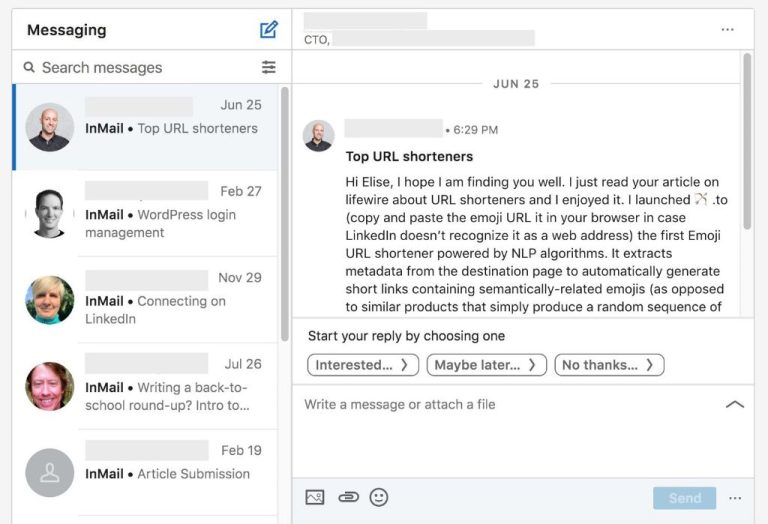InMail messages on LinkedIn are an important tool for making professional connections and growing your network. However, with LinkedIn’s algorithmic feed and the high volume of messages people receive, it can sometimes feel like your InMail messages are getting lost in the shuffle. So an important question is: do people actually see the InMails you send?
InMail Open Rates
The good news is that yes, InMail messages do get seen. According to LinkedIn, the average InMail open rate is around 30-50%. This means about 1 in 3 recipients will open an InMail message sent to them. Here are some key stats on InMail open rates:
| InMail Stat | Rate |
|---|---|
| Average InMail Open Rate | 30-50% |
| InMail Open Rate for Recipients You’re Connected To | 45-60% |
| InMail Open Rate for Recipients You’re Not Connected To | 25-40% |
As you can see, the open rate is higher when messaging someone you’re already connected with on LinkedIn. But even when messaging strangers, about 1 in 4 open the InMail on average.
Factors That Impact InMail Open Rates
There are several factors that can influence whether someone opens and reads an InMail message or not. Here are some of the key factors:
Relevance of the Message
If the InMail content is closely aligned with the recipient’s interests and goals, they are much more likely to open it. Taking the time to personalize your message and make it highly relevant has a big impact. Generic or spray-and-pray InMails tend to get ignored.
Subject Line
The subject line is prime real estate to capture the recipient’s attention. Subject lines that are compelling, urgent, or create curiosity tend to have higher open rates according to LinkedIn.
Relationship with the Sender
As noted earlier, InMails from people you already know have higher open rates. The strength of your existing relationship or lack thereof will influence if they read your message.
Sender’s Profile Strength
If you have a complete, professional LinkedIn profile it boosts your credibility and makes recipients more likely to open your InMail. Sparse or unprofessional profiles get fewer opens.
Recipient’s Notification Settings
Some recipients limit LinkedIn notifications or rarely check their LinkedIn account. Even a great InMail will go unopened if the recipient has notifications off.
Best Practices to Get Your InMail Opened
Here are some tips to boost your InMail open rates based on the factors above:
Personalize the Message
Avoid templates and generic messages. Research the recipient’s experience and goals. Then tailor the message to their specific needs and interests.
Catchy Subject Line
Use power words like “urgent” or “time-sensitive.” Ask questions like “30 minutes to discuss your career?” Plant intrigue like “Recent news I thought you should know.”
Highlight Shared Connections
If you have shared connections, mention them by name in the InMail. This social proof builds credibility.
Proofread for Typos
Grammar and spelling errors undermine your professional brand. Always proofread before sending.
Follow Up Persistently
If they don’t respond the first time, follow up again in a week or two. Persistence pays off.
When Do People Read InMail Messages?
Understanding when your recipients are most likely to see and read your InMail can help inform your send times. Here’s an overview of peak InMail activity:
Morning
8-10 AM tends to be a high engagement window for LinkedIn usage and InMail opens. People check LinkedIn messages in the morning as part of their routine.
Lunch Hour
Recipient often use a portion of their lunch break to catch up on LinkedIn notifications. InMail open rates peak around 12-1 PM.
Evenings
After dinner from 6-9 PM is another prime engagement window as people catch up on the day’s messages.
Tuesdays & Wednesdays
Midweek tends to see higher InMail engagement than Mondays, Fridays, and weekends. Tuesday and Wednesday evenings are good send times.
InMail vs. LinkedIn Messages: Which Gets More Visibility?
Beyond InMail, regular LinkedIn Messages can also be an effective way to reach out to connections. But which communication method sees higher open and response rates? Here’s an overview of how InMail and LinkedIn Messages compare:
| Metric | InMail | LinkedIn Message |
|---|---|---|
| Open Rates | 30-50% | 45-60% |
| Response Rates | 10-15% | 15-25% |
As you can see, regular LinkedIn messages tend to have better open and response rates because they are sent exclusively to your 1st-degree connections. With InMail, you can reach anyone but open and response rates are lower when messaging people you have no existing relationship with.
When to Use InMail vs. Messages
As a general rule, use LinkedIn Messages when contacting 1st-degree connections and InMail when contacting 2nd & 3rd degree connections or strangers.
Conclusion
On average, about 30-50% of InMail messages sent on LinkedIn get opened and read by the recipient. This open rate is lower when contacting strangers but higher when messaging existing connections. Factors like personalization, subject lines, and sender reputation all influence InMail open rates. Morning and evenings tend to see higher engagement. While InMail is needed to reach beyond your immediate network, regular LinkedIn Messages tend to see higher response rates from current connections. Overall, InMail remains an important tool for expanding your LinkedIn network if used strategically.


